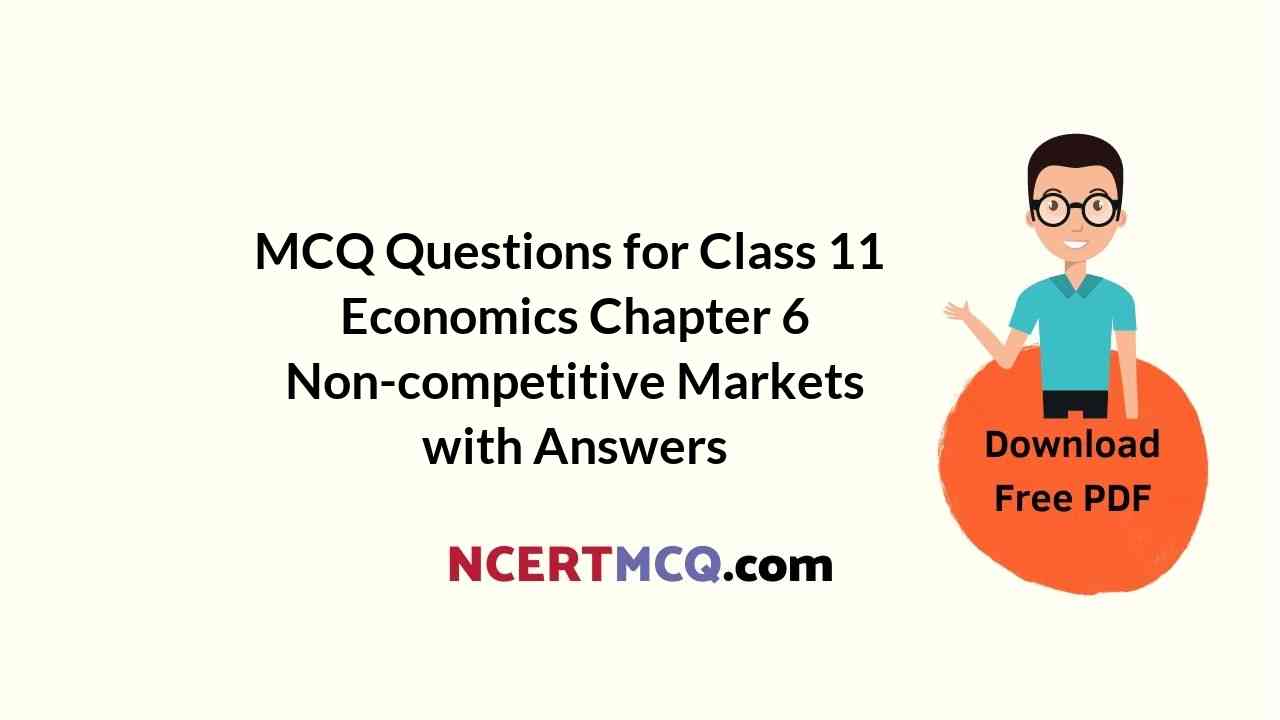Check the below NCERT MCQ Questions for Class 11 Economics Chapter 6 Non-competitive Markets with Answers Pdf free download. MCQ Questions for Class 11 Economics with Answers were prepared based on the latest exam pattern. We have provided Non-competitive Markets Class 11 Economics MCQs Questions with Answers to help students understand the concept very well.
Class 11 Economics Chapter 6 Non-competitive Markets MCQ With Answers
Economics Class 11 Chapter 6 MCQs On Non-competitive Markets
MCQ On Market In Economics Class 11 Chapter 6 Question 1.
Which of the following is not the feature of an imperfect competition?
(a) Large number of buyers
(b) Single seller
(c) Homogeneous products
(d) Price maker
Answer
Answer: (c) Homogeneous products
Explanation:
A homogeneous product is one that cannot be distinguished from competing products from different suppliers. In other words, the product has essentially the same physical characteristics and quality as similar products from other suppliers. One product can easily be substituted for the other.
MCQ On Forms Of Market Class 11 Chapter 6 Question 2.
A monopolist is a price
(a) Acceptor
(b) Taker
(c) Giver
(d) Maker
Answer
Answer: (d) Maker
Explanation:
A monopoly firm is a price maker or price setter because it is the sole producer of a product.This is in contrast to a competitive firm which is a price taker with zero market power. Because in the monopoly, there is only one seller for the product, any one who wants to buy the product must buy it from the monopolist.
MCQ On Market Class 11 Chapter 6 Question 3.
The firm and the industry are one and the same in:
(a) Monopolistic competition
(b) Monopoly
(c) Duopoly
(d) Oligopoly
Answer
Answer: (b) Monopoly
Explanation:
A type of market structure, where the firm has absolute power to produce and sell a product or service having no close substitutes. In simple terms, monopolised market is one where there is a single seller, selling a product with no near substitutes to a large number of buyers. As the firm and industry are one and the same thing in the monopoly market, so it is a single-firm industry. There is zero or negative cross elasticity of demand for a monopoly product. Monopoly can be found in public utility services such as telephone, electricity and so on.
MCQ Questions For Class 11 Statistics Economics Chapter 6 Question 4.
Which of the following is not a characteristic feature of imperfect competition?
(a) Prices vary from seller to seller
(b) All the products are homogeneous
(c) Profits of the seller is included in the price
(d) None of above
Answer
Answer: (b) All the products are homogeneous
Explanation:
Imperfect competition is a competitive market situation where there are many sellers, but they are selling heterogeneous (dissimilar) goods as opposed to the perfect competitive market scenario. As the name suggests, competitive markets that are imperfect in nature.
Question 5.
Market which has two firms is known as
(a) Duopoly
(b) Monopolistic Competition
(c) Oligopoly
(d) None of These
Answer
Answer: (a) Duopoly
Explanation:
Oligopoly is a market structure with a small number of firms, none of which can keep the others from having significant influence. The concentration ratio measures the market share of the largest firms. A monopoly is one firm, duopoly is two firms and oligopoly is two or more firms.
Question 6.
Under which of the following forms of market structure a firm has no control over the price of its product?
(a) Monopoly
(b) Perfect competition
(c) Oligopoly
(d) Monopolistic competition
Answer
Answer: (b) Perfect competition
Explanation:
Pure or perfect competition is a theoretical market structure in which the following criteria are met: All firms sell an identical product (the product is a “commodity” or “homogeneous”). All firms are price takers (they cannot influence the market price of their product). Market share has no influence on prices.
Question 7.
Oligopoly having identical products is known as
(a) Pure oligopoly
(b) Collusive oligopoly
(c) Independent oligopoly
(d) None of above
Answer
Answer: (a) Pure oligopoly
Question 8.
Price discrimination can take place only in
(a) Perfect competition
(b) Oligopoly
(c) Monopolistic competition
(d) Monopoly
Answer
Answer: (d) Monopoly
Question 9.
Which market have characteristic of product differentiation
(a) Monopolistic competition
(b) Oligopoly
(c) Monopoly
(d) Perfect competition
Answer
Answer: (a) Monopolistic competition
Explanation:
Monopolistic competition occurs when an industry has many firms offering products that are similar but not identical. Firms in monopolistic competition typically try to differentiate their product in order to achieve in order to capture above market returns.
Question 10.
Under monopoly form of market, TR is maximum when
(a) MR is maximum
(b) MR < 0
(c) MR > 0
(d) MR is zero
Answer
Answer: (d) MR is zero
Explanation:
Marginal revenue means additional revenue generate/received from the sale of additional unit of output.In imperfect (monopoly) when TR increases MR decreases , when TR become maximum MR reaches to zero.
We hope the given NCERT MCQ Questions for Class 11 Economics Chapter 6 Non-competitive Markets with Answers Pdf free download will help you. If you have any queries regarding CBSE Class 11 Economics Non-competitive Markets MCQs Multiple Choice Questions with Answers, drop a comment below and we will get back to you soon.
Class 11 Microeconomics MCQ:
